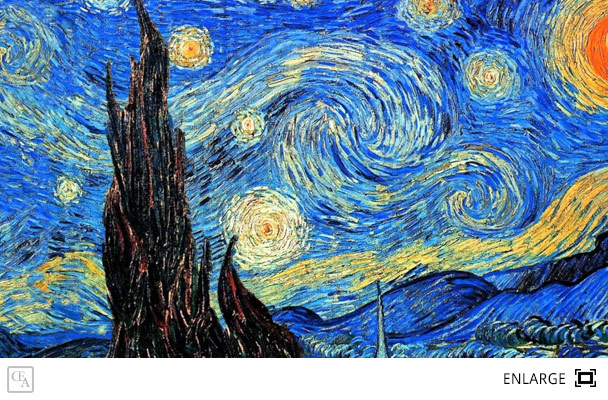
It is a standard oil painting on canvas and depicts a cityscape underneath a starry night sky, possibly from the view of a window. It is one of the most immediately recognizable paintings in Western art, and one of van Gogh's most famous and important works. Ironically, van Gogh himself was not satisfied with The Starry Night and considered the work to be “a failure,” and declined to send the painting to his brother later on. He believed the painting to be too abstract, with the notable stars in the painting being too large and exaggerated for his taste.
In 1888, van Gogh suffered a kind of nervous breakdown as a result of a conflict with a friend of his and his brother. In a fit, he mutilated his ear, and reportedly sent the severed ear to a prostitute that he regularly tended to visit. He nearly bled to death from the ordeal, and barely survived after being taken to the hospital by the police. After this episode, he checked himself into the local insane asylum in Saint Paul-de-Mausole, where he spent roughly a year. There, he had two rooms, one for sleeping, and one to serve as a studio for his paintings. The isolation inflicted upon him by his stay limited the range of subjects, and during this time a lot of his works were depictions of mundane subjects and of nature and the surrounding views from his window. The Starry Night is one such painting, which is meant to depict the view out of his asylum window before sunrise.
In the painting, the viewer can see a swirling dark blue sky in the typical style of van Gogh's works. Some art critics interpret these swirls as visual depictions of wind blowing through the night. There are many stars, exaggerated in their brightness, and a big crescent moon in the right-hand corner among what appears to be flowing clouds or fog. In the foreground, a cypress tree—a possible symbol of death, according to some critics—reaches up into the night, and the brightest star in the image—which is probably no star at all, but actually the planet Venus—sits just to the right of it. In the background a village can clearly be seen, with a few windows in some houses lit up from the inside. A church with a tall steeple is visible among the houses and serves as something of a focal point. According to research, this village was not literally visible from van Gogh's asylum window, and was merely a stylistic choice which he added. Further into the background of the painting, there are a series of rolling hills and forest thickets as the image moves towards a more natural setting. Beyond the hills, nothing is visible, and the horizon appears to be shrouded in clouds. It is the only night scene that van Gogh painted during his stay in the Saint Paul-de-Mausole asylum.
 Van Gogh: Complete Works
Van Gogh: Complete Works